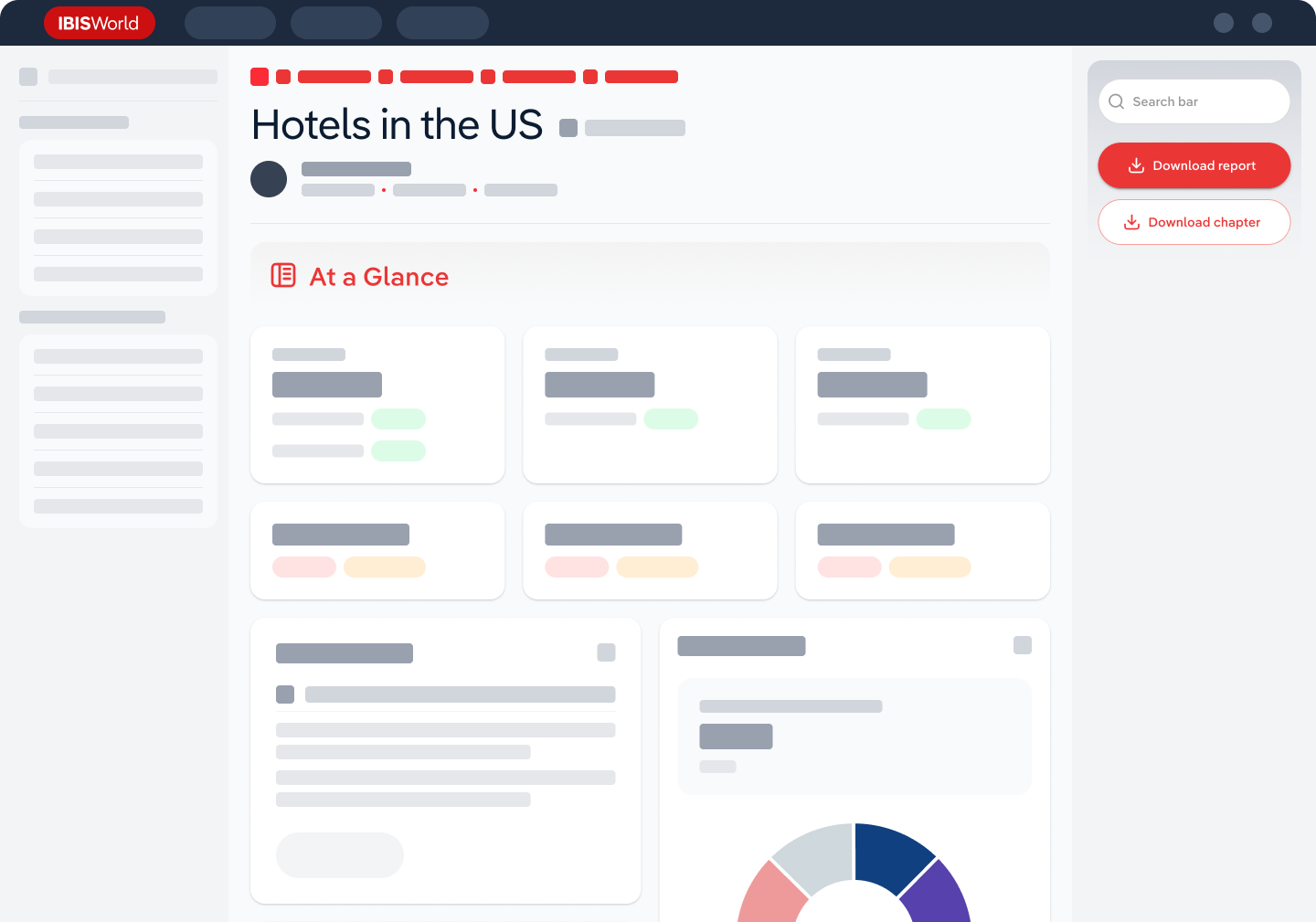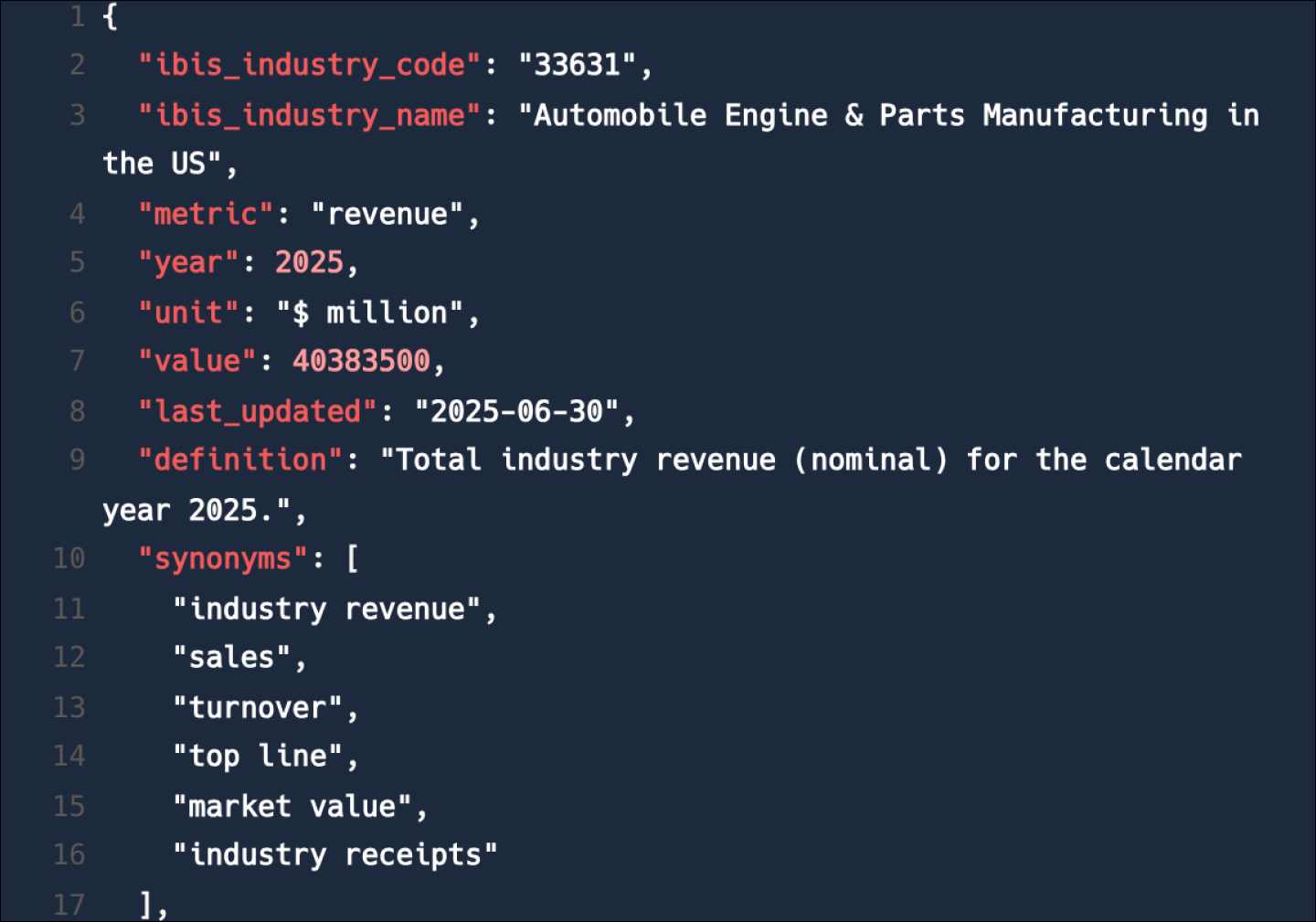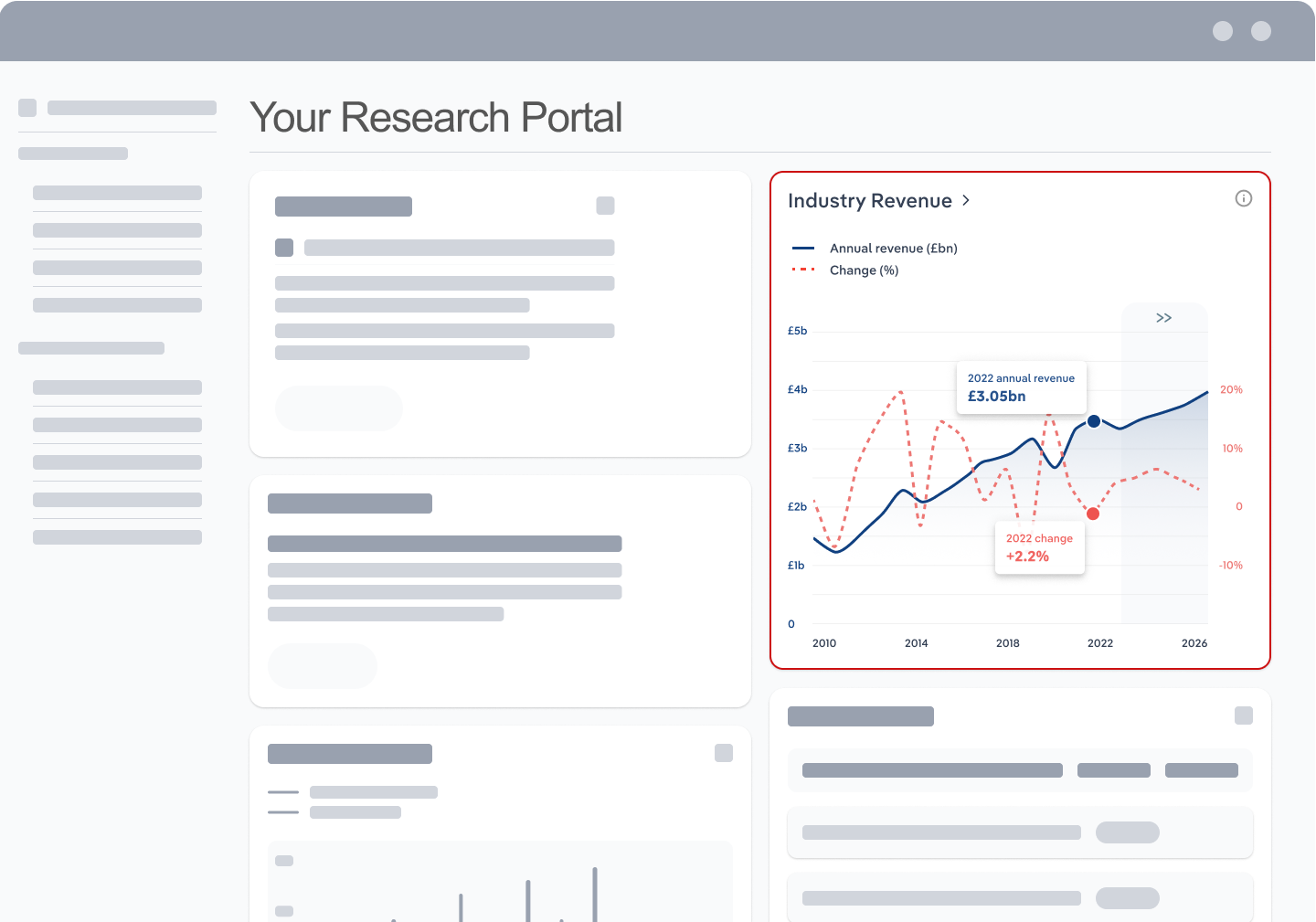Industry Statistics and Trends
Market size and recent performance (2015-2030)
Industry revenue has grown at a CAGR of 1.1 % over the past five years, to reach an estimated $31.1bn in 2025.
Trends and Insights
Banks maintain strong mortgage revenues as higher rates offset cooling property prices, yet cost pressures persist
- Mortgage lending remains central to bank performance, with interest rate shifts dictating demand and overall industry performance. Since August 2021, successive rate hikes have driven mortgage-related revenue growth as higher variable and fixed rates bolster interest income. The RBNZ pivoted from a 0.25% cash rate in early 2020 to a peak of 5.5% in late 2023, and kept it high at 4.25% in 2024. This shift signals a stricter inflation stance, amplifying banks’ margins on lending. RBNZ has since further cut rates, now at 3.75% as of February 2025.
- Additional trends and insights available with purchase
Industry outlook (2025-2030)
Market size is projected to grow over the next five years.
Trends and Insights
While inflationary pressures loom, cash rate shifts create a volatile environment for banks
- As of January 2025, the Reserve Bank of New Zealand (RBNZ) has set the Official Cash Rate (OCR) at 4.25%, following a 50-basis-point reduction in November 2024 that marked the third cut in four months. This monetary easing responds to muted investment, sluggish consumer spending and ongoing inflationary pressures. The RBNZ signalled the possibility of additional cuts – potentially 75 basis points – should recessionary conditions persist, with a longer-term goal of stabilising the OCR between 2.5% and 3.5% by late 2025. Such adjustments aim to balance curbing inflation against supporting economic recovery. Economic conditions are on track to continue to stabilise over the coming years, with inflation poised to ease, leading to an easing of the cash rate.
Biggest companies in the Banking in New Zealand
| Company | Market Share (%)
2025 | Revenue ($m)
2025 |
|---|---|---|
ANZ Bank (New Zealand) | 8,872.8 | |
ASB Holdings | 6,192.0 | |
National Australia | 6,102.0 |
To view the market share and analysis for all 6 top companies in this industry, view purchase options.
Products & Services Segmentation
Industry revenue is measured across several distinct product and services lines, including Mortgages, Business, personal and credit card loans and Other banking services. Mortgages is the largest segment of the Banking in New Zealand.
Trends and Insights
Mortgage uptake has exploded on the back of low interest rates
- The mortgage interest segment encompasses fixed-rate, variable-rate and hybrid loans for owner-occupiers and residential investors. Fluctuations in the Official Cash Rate (OCR) significantly influence borrowing costs, with low rates boosting mortgage demand and higher rates dampening lending activities but with higher returns.
- More insights available in the full report
Table of Contents
About this industry
Industry definition
Banks handle financial processes like accepting deposits and issuing consumer and commercial loans.
What's included in this industry?
Products and services covered in the Banking industry in New Zealand include Mortgages, Business, personal and credit card loans, Term deposits and Savings accounts.Companies
Companies covered in the Banking industry in New Zealand include ANZ Bank (New Zealand), ASB Holdings and National Australia.Purchase this report to view all 6 major companies in this industry.
Related Terms
Related terms covered in the Banking industry in New Zealand include tier 1 capital, net interest spread and cash rate.Industry Code
ANZSIC 6221 - Banking in New Zealand
Performance
Get an indication of the industry's health through historical, current and forward-looking trends in the performance indicators that make or break businesses.
Analyst insights
RBNZ has kept the cash rate high in recent years but is trending downward with less inflationary pressure. This elevated rate environment has prompted banks to raise interest...
In this chapter (4)
- Current Performance
- Outlook
- Volatility
- Life Cycle
Key metrics
- Annual Revenue, Recent Growth, Forecast, Revenue Volatility
- Number of Employees, Recent Growth, Forecast, Employees per Business, Revenue per Employee
- Number of Businesses, Recent Growth, Forecast, Employees per Business, Revenue per Business
- Total Profit, Profit Margin, Profit per Business
Charts
- Revenue, including historical (2015-2024) and forecast (2025-2030)
- Employees, including historical (2015-2024) and forecast (2025-2030)
- Businesses, including historical (2015-2024) and forecast (2025-2030)
- Profit, including historical (2015-2025)
- Industry Volatility vs. Revenue Growth
- Industry Life Cycle
Detailed analysis
- Trends in supply, demand and current events that are driving current industry performance
- Expected trends, economic factors and ongoing events that drive the industry's outlook
- Key success factors for businesses to overcome volatility
- How contribution to GDP, industry saturation, innovation, consolidation, and technology and systems influence the industry's life cycle phase.
Products and Markets
Learn about an industry's products and services, markets and trends in international trade.
Analyst insight
Mortgage demand exploded at the start of the period because of low interest rates. Although this is slowing as interest rates climb, it has offered banks higher overall mortg...
In this chapter
- Products & Services
- Major Markets
Key metrics
- Largest market segment and value in 2025
- Product innovation level
Charts
- Products & services segmentation in 2025
- Major market segmentation in 2025
Detailed analysis
- Trends impacting the recent performance of the industry's various segments
- Innovations in the industry's product or service offering, specialization or delivery method
- Key factors that successful businesses consider in their offerings
- Buying segments and key trends influencing demand for industry products and services
Geographic Breakdown
Discover where business activity is most concentrated in an industry and the factors driving these trends to find opportunities and conduct regional benchmarking.
Analyst insights
Auckland is New Zealand’s financial epicentre, housing the headquarters of major banks. This strategic positioning capitalises on the city’s sizable economy, creating a dynam...
In this chapter (1)
- Business Locations
Charts
- Share of revenue, establishment, wages and employment in each region
- Share of population compared to establishments in each region in 2025
Tables
- Number and share of establishments in each region in 2025
- Number and share of revenue each region accounts for in 2025
- Number and share of wages each region accounts for in 2025
- Number and share of employees in each region in 2025
Detailed analysis
- Geographic spread of the industry across Asia Pacific, and trends associated with changes in the business landscape
- Key success factors for businesses to use location to their advantage
Competitive Forces
Get data and insights on what's driving competition in an industry and the challenges industry operators and new entrants may face, with analysis built around Porter's Five Forces framework.
Analyst insights
New Zealand's stringent regulations create high entry barriers for domestic and foreign banks. The RBNZ demands capital adequacy and liquidity compliance, alongside close scr...
In this chapter (4)
- Concentration
- Barriers to Entry
- Substitutes
- Buyer & Supplier Analysis
Key metrics
- Industry concentration level
- Industry competition level and trend
- Barriers to entry level and trend
- Substitutes level and trend
- Buyer power level and trend
- Supplier power level and trend
Charts
- Market share concentration among the top 4 suppliers from 2020-2025
- Supply chain including upstream supplying industries and downstream buying industries, flow chart
Detailed analysis
- Factors impacting the industry’s level of concentration, such as business distribution, new entrants, or merger and acquisition activity.
- Key success factors for businesses to manage the competitive environment of the industry.
- Challenges that potential industry entrants face such as legal, start-up costs, differentiation, labor/capital intensity and capital expenses.
- Key success factors for potential entrants to overcome barriers to entry.
- Competitive threats from potential substitutes for the industry’s own products and services.
- Key success factors for how successful businesses can compete with substitutes.
- Advantages that buyers have to keep favorable purchasing conditions.
- Advantages that suppliers have to maintain favorable selling conditions.
- Key success factors for how businesses can navigate buyer and supplier power.
Companies
Learn about the performance of the top companies in the industry.
Analyst insights
The banking sector's four-pillar structure has fostered an environment of dominant major players. Their economies of scale allow for a healthy profit margin buffer, and their...
In this chapter
- Market Share Concentration
- Companies
- Company Spotlights
Charts
- Industry market share by company in 2021 through 2025
- Major companies in the industry, including market share, revenue, profit and profit margin in 2025
- Overview of ANZ Bank (New Zealand)'s performance by revenue, market share and profit margin from 2019 through 2025
- Overview of ASB Holdings's performance by revenue, market share and profit margin from 2019 through 2025
- Overview of National Australia's performance by revenue, market share and profit margin from 2019 through 2025
- Overview of revenue, market share and profit margin trend for 3 additional companies
Detailed analysis
- Description and key data for ANZ Bank (New Zealand), and factors influencing its performance in the industry
- Description and key data for ASB Holdings, and factors influencing its performance in the industry
- Description and key data for National Australia, and factors influencing its performance in the industry
- Description, key data and performance trends for 3 additional companies
External Environment
Understand the demographic, economic and regulatory factors that shape how businesses in an industry perform.
Analyst insights
Loan-to-value restrictions were temporarily eased at the start of the period. This move opened up credit lines for prospective homebuyers and investors, but the restrictions ...
In this chapter
- External Drivers
- Regulation & Policy
- Assistance
Key metrics
- Regulation & policy level and trend
- Assistance level and trend
Charts
- Regulation & Policy historical data and forecast (2015-2030)
- Assistance historical data and forecast (2015-2030)
Detailed analysis
- Demographic and macroeconomic factors influencing the industry, including Regulation & Policy and Assistance
- Major types of regulations, regulatory bodies, industry standards or specific regulations impacting requirements for industry operators
- Key governmental and non-governmental groups or policies that may provide some relief for industry operators.
Financial Benchmarks
View average costs for industry operators and compare financial data against an industry's financial benchmarks over time.
Analyst insights
Bank profit margins are closely linked to the cash rate and operating costs. Recent monetary tightening and rising expenses from technology upgrades have squeezed margins.
In this chapter
- Cost Structure
- Financial Ratios
- Key Ratios
Key metrics
- Profit margin, and how it compares to the sector-wide margin
- Average wages, and how it compares to the sector-wide average wage
- Largest cost component as a percentage of revenue
- Industry average ratios for days' receivables, industry coverage and debt-to-net-worth ratio
Charts
- Average industry operating costs as a share of revenue, including purchases, wages, depreciation, utilities, rent, other costs and profit in 2025
- Average sector operating costs as a share of revenue, including purchases, wages, depreciation, utilities, rent, other costs and profit in 2025
- Investment vs. share of economy
Data tables
- Cash Flow & Debt Service Ratios (2015-2030)
- Revenue per Employee (2015-2030)
- Revenue per Enterprise (2015-2030)
- Employees per Establishment (2015-2030)
- Employees per Enterprise (2015-2030)
- Average Wage (2015-2030)
- Wages/Revenue (2015-2030)
- Establishments per Enterprise (2015-2030)
- IVA/Revenue (2015-2030)
- Imports/Demand (2015-2030)
- Exports/Revenue (2015-2030)
Detailed analysis
- Trends in the cost component for industry operators and their impact on industry costs and profitability
Key Statistics
Industry Data
Data Tables
Including values and annual change:
- Revenue (2015-2030)
- IVA (2015-2030)
- Establishments (2015-2030)
- Enterprises (2015-2030)
- Employment (2015-2030)
- Exports (2015-2030)
- Imports (2015-2030)
- Wages (2015-2030)
Top Questions Answered
Unlock comprehensive answers and precise data upon purchase. View purchase options.
What is the market size of the Banking industry in New Zealand in 2025?
The market size of the Banking industry in New Zealand is $31.1bn in 2025.
How many businesses are there in the Banking industry in New Zealand in 2025?
There are 26 businesses in the Banking industry in New Zealand, which has declined at a CAGR of 0.0 % between 2020 and 2025.
How may import tariffs affect the Banking industry in New Zealand?
The Banking industry in New Zealand is unlikely to be materially impacted by import tariffs with imports accounting for a low share of industry revenue.
How may export tariffs affect the Banking industry in New Zealand?
The Banking industry in New Zealand is unlikely to be materially impacted by export tariffs with exports accounting for a low share of industry revenue.
Has the Banking industry in New Zealand grown or declined over the past 5 years?
The market size of the Banking industry in New Zealand has been growing at a CAGR of 1.1 % between 2020 and 2025.
What is the forecast growth of the Banking industry in New Zealand over the next 5 years?
Over the next five years, the Banking industry in New Zealand is expected to grow.
What are the biggest companies in the Banking industry in New Zealand?
The biggest companies operating in the Banking industry in New Zealand are ANZ Bank (New Zealand), ASB Holdings and National Australia
What does the Banking industry in New Zealand include?
Mortgages and Business, personal and credit card loans are part of the Banking industry in New Zealand.
Which companies have the highest market share in the Banking industry in New Zealand?
The company holding the most market share in the Banking industry in New Zealand is ANZ Bank (New Zealand).
How competitive is the Banking industry in New Zealand?
The level of competition is high and increasing in the Banking industry in New Zealand.
Methodology
How are IBISWorld reports created?
IBISWorld has been a leading provider of trusted industry research for over 50 years to the most successful companies worldwide. With offices in Australia, the United States, the United Kingdom, Germany and China, we are proud to have local teams of analysts that conduct research, data analysis and forecasting to produce data-driven industry reports.
Our analysts start with official, verified and publicly available sources of data to build the most accurate picture of each industry. Analysts then leverage their expertise and knowledge of the local markets to synthesize trends into digestible content for IBISWorld readers. Finally, each report is reviewed by one of IBISWorld’s editors, who provide quality assurance to ensure accuracy and readability.
IBISWorld relies on human-verified data and human-written analysis to compile each standard industry report. We do not use generative AI tools to write insights, although members can choose to leverage AI-based tools within the platform to generate additional analysis formats.
What data sources do IBISWorld analysts use?
Each industry report incorporates data and research from government databases, industry-specific sources, industry contacts, and our own proprietary database of statistics and analysis to provide balanced, independent and accurate insights.
Key data sources in New Zealand include:
- Statistics New Zealand
- New Zealand Company Register
- Ministry of Business, Innovation & Employment
Analysts also use industry specific sources to complement catch-all sources, although their perspective may focus on a particular organization or representative body, rather than a clear overview of all industry operations. However, when balanced against other perspectives, industry-specific sources provide insights into industry trends.
These sources include:
- Industry and trade associations
- Industry federations or regulators
- Major industry players annual or quarterly filings
Finally, IBISWorld’s global data scientists maintain a proprietary database of macroeconomic and demand drivers, which our analysts use to help inform industry data and trends. They also maintain a database of statistics and analysis on thousands of industries, which has been built over our more than 50-year history and offers comprehensive insights into long-term trends.
How does IBISWorld forecast its data?
IBISWorld’s analysts and data scientists use the sources above to create forecasts for our proprietary datasets and industry statistics. Depending on the dataset, they may use regression analysis, multivariate analysis, time-series analysis or exponential smoothing techniques to project future data for the industry or driver. Additionally, analysts will leverage their local knowledge of industry operating and regulatory conditions to impart their best judgment on the forecast model.
IBISWorld prides itself on being a trusted, independent source of data, with over 50 years of experience building and maintaining rich datasets and forecasting tools. We are proud to be the keystone source of industry information for thousands of companies across the world.
Learn more about our methodology and data sourcing on the Help Center.










